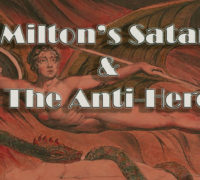Do what thou wilt shall be the whole of the Law.
John Milton’s Paradise Lost was one of the books that Aleister Crowley thought was important enough to pack on his alpine expeditions into the Himalayas. An epic poem that everyone knows about, if they haven’t read it, Paradise Lost is one of the pillars of literary English.
Milton was a blind rebel and conflicted Puritan. As a member of the government of Oliver Cromwell after the English Civil War (1641-1648) he defended the new republic’s execution of King Charles I by insisting that a free people needed no king. He also wrote essays on the necessity of free speech and press, equality in marriage and the challenges of representative power.
Versed in many languages Milton had read the Bible in the original Hebrew, Greek and Latin before he went blind. He composed the entirety of his epic about God, Satan and the Fall of Man in his head over a decade after he went blind to his daughters who wrote it down. Feeling the Christian creation myth needed a little clarifying he personally felt he was filling in the blanks.
Notably what is striking about Paradise Lost is much of the epic is seen from the perspective of Satan, one of the most complex characters in western literature. While Milton was a “heretical” Christian, who disliked the authoritarian structure of both the Church of England and Roman Catholicism, many readers believe, like Blake “he took the devil’s side without knowing it.”
This book with phrases like “darkness visible” and “red right hand” is still open to interpretation. Filled with Milton’s knowledge of not only the Bible but of angel lore, demonology, heresies and world mythology, an easy interpretation of this work is not available.
Milton the rebel, sees the first rebellion as the origin of evil. But he also sees it as something necessary for the human race to have a challenge worthy of achieving a great potential. Dismissed as “boring” by those who haven’t read it, Paradise Lost, set in a Copernican universe, is a seminal text about the birth of modernity, the ideas that led to the French and American revolutions, the corrosive power of greed, the psychology of evil and the burdens of responsibility.
Love is the law, love under will.


